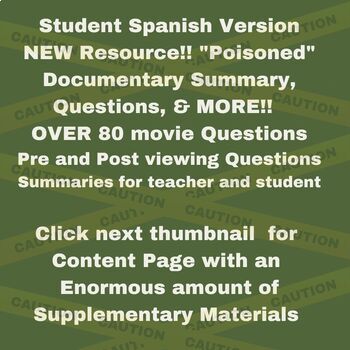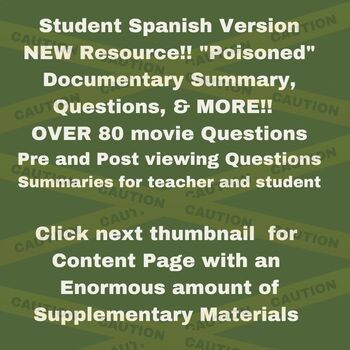New!! Spanish & English Bundle "Poisoned: The Dirty Truth About Your Food"
- Zip
Products in this Bundle (2)
Description
New on TPT: "Poisoned: The Dirty Truth About Your Food " Documentary!
Includes both Spanish and English versions.
Revised Edition: Attention teachers! Dive into the thrilling and eye-opening world of food safety with the exclusive TPT resources for the new hit Netflix documentary, "Poisoned: The Dirty Truth About Your Food" This educational package is designed to accompany the film, engaging your students in a gripping real-life exploration of food contamination and public health.
What's Included?
- 80 Movie Review Questions
- Pre-Viewing Movie Questions
- 3 pages with food safety guidelines and information
- Food Safety Vocabulary Handout
- Food Safety Vocabulary Worksheet
- Student Research Project List Page
- Science Lab List Page
- Career Handout Page
- Web Resource Page with CDC, USDA, and FDA links to documents
- Free Food Safety Resources
Teacher Pages
1) )5 Day Example Lesson Plan
2) Teacher Summary of the documentary
3) Pre-Documentary Student Discussion Questions
Student Pages
1) Student Summary: "Poisoned: The Dirty Truth About Your Food".
Student Handout A
2) Introduction to Food Safety and Bacterial Concerns
Student Handout B
3) Preview Documentary Questions for Students
Student Handout C
4) "Poisoned: The Dirty Truth about Your Food" Movie Review Questions Student Handout D
5) Microscopic Food Safety & Microbiology Vocabulary
Student Handout E
6) Microscopic Food Safety & Microbiology Matchup
Student Handout F
7) Food Safety and Hygiene Guidelines
Student Handout G
8) Cooking Safely in the Kitchen
Student Handout H
9) U.S. Government Agencies and Their Roles in Ensuring Public Safety and Health Student Handout I
10) Post Viewing Student Reflection QuestionsStudent Handout J
11) Microbiology, Food Safety and Ethics Research Project Topics
Student Handout K
12) Careers in Food Microbiology and Safety:
Student Handout L
13) U.S. Microbiology and Food Safety Web Resources
Student Handout M
14) Bonus: U.S. Food and Safety Web
15) Bonus: Microscopic Explorations Labs: Food Safety and Hygiene Labs
16) Links to free Federal Curriculum Resources
17) NGSS and “Poisoned: The Truth about Your Food”
More than a worksheet!
This resource is more than just a supplement; it's a captivating educational experience that fosters critical thinking, empathy, and awareness about a pressing global issue. Transform a simple movie-watching session into an immersive learning adventure!
Engage students with research projects, food safety and microbiology labs, movie questions, previewing questions, and resources available from the USDA and FDA.
Ready to ignite curiosity and spark meaningful discussions in your classroom? Click the 'Add to Cart' button now and enrich your teaching with "Poisoned: The Dirty Truth About Your Food" TPT resources! Invest in education that entertains and enlightens; your students will thank you!



